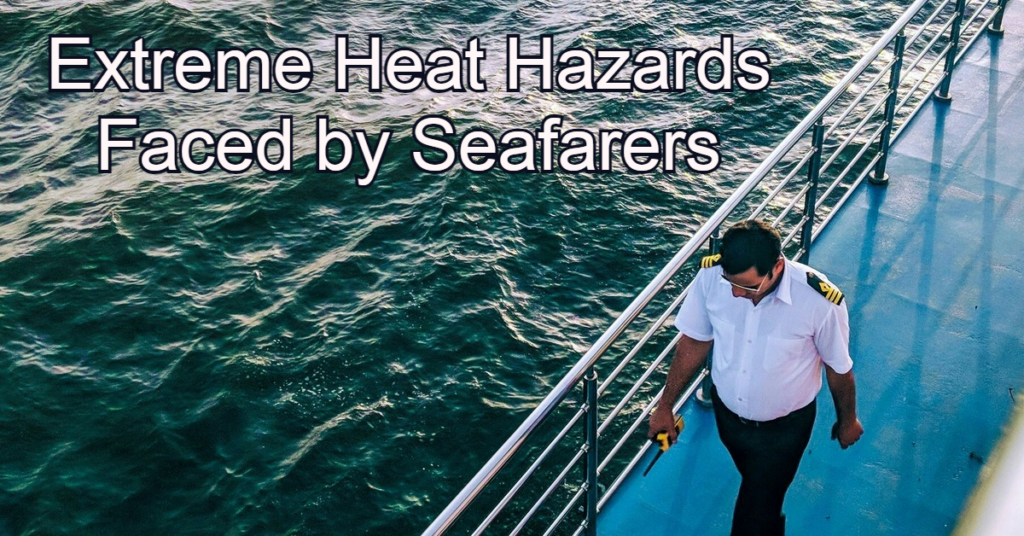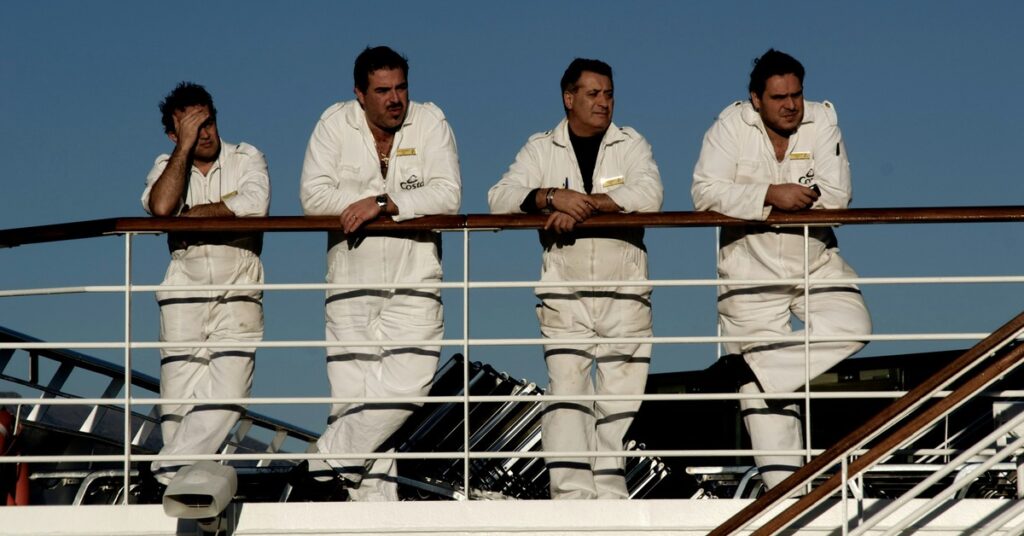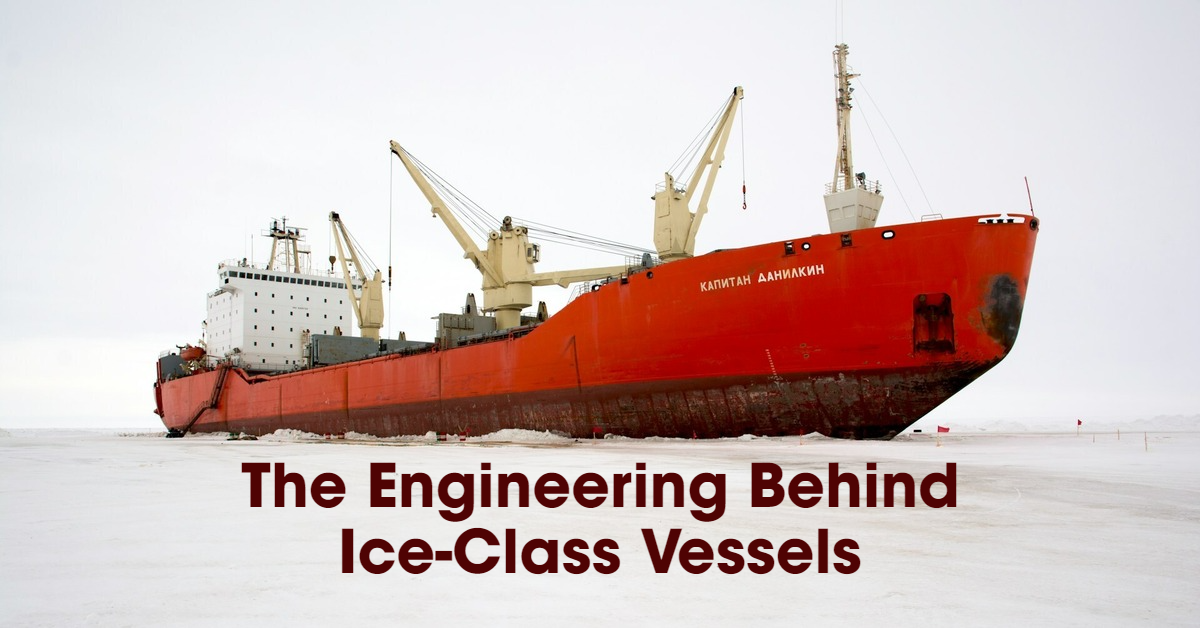“All in a hot and copper sky, the bloody sun at noon, right above the mast did stand, no bigger than the moon.” Despite its small size, the sun in Coleridge’s famous poem “The Rime of the Ancient Mariner” baked torture down on those at sea, depriving the unfortunate sailors of even a single drop of water amid the vast ocean. Although the poem is fictional, the extreme heat hazards mariners face are real indeed.
The combination of water, sun and little available shade can turn a ship’s deck into a brick-oven pizza pan freshly emerged from the flames. What must sailors know to stay safe and make it back to shore healthy and happy? Here’s a closer look at the extreme heat hazards seafarers face and the precautions and procedures they must know before setting sail.

The Effect of Sun and Water on the Human Body
Water amplifies the effect of sunlight, acting like a mirror to reflect its UV rays and multiplying the amount bombarding human body cells. Excessive UVA and UVB exposure, the two most harmful types of radiation, can cause premature aging, eye damage and temporary blindness while suppressing the immune response and increasing skin cancer risk.
The proximity to water itself can pose a threat, and not only from the drowning risk. While a dip can cool a person’s internal body temperature, it can also make them feel less thirsty, increasing dehydration risk. Alcohol further decreases body fluids through excess urination, which is only one reason why going overboard at sea can result in severe health consequences.
Factors That Affect the Heat Index at Sea
The combination of sun and water that makes the beach a frequent site of heat-related illness becomes even more intense at sea. A ship’s hold is often the only place to get a true break from the almighty spotlight in the sky, and these areas can grow stuffy and uncomfortable quickly on vessels that lack adequate climate control. While the right bimini top provides shade on jet-style boats and pontoons, mariners still face high temperatures and humidity.
Unique Risks of Heat-Related Illnesses at Sea
The closer someone is to emergency medical services, the better their chances of surviving extreme heat hazards. However, a ship at sea may be hundreds of miles from the nearest hospital, and getting there is no easy task. It’s the reason why cruise ships often refuse pregnant women past 24 weeks because the vessel simply isn’t equipped to provide prenatal and early infant care.
Typically, vessels that traverse the ocean have at least two doctors on board and adequate facilities to provide a basic level of care. However, it doesn’t include specialty treatments, and supplies are necessarily limited — getting seriously injured or ill at sea is definitely bad news.
Identifying Signs of Heat-Related Illness
Because of ocean travel’s unique risks, every mariner should know how to identify signs of heat-related illnesses and take immediate action to address them before they get worse. It’s also crucial to review the location of the ship’s first-aid kit, what it contains and how to use the contents.
Every mariner should recognize the signs of the following five heat-related illnesses.
Heat Stroke
Heat stroke occurs when someone’s internal body temperature reaches 104° Fahrenheit or more. At this level, the body can no longer regulate its temperature, the sweating mechanism ceases and organ failure can occur. Anyone who notices the following signs should immediately move the affected individual out of the sun, remove as much clothing as possible and begin cooling measures.
Early signs of heat stroke can be identified by hot, dry skin the appears red, a rapid pulse, confusion, disorientation, dizziness or lightheadedness. These symptoms are often brought on along a significant rise in temperature, typically 102°F or higher, and a drop in blood pressure. As it progresses, you’re likely to notice heavy breathing, pounding headaches, fatigue, nausea, and even vomiting or loss of consciousness.
Cooling can occur through damp towels soaked in ice water. Although sipping water can rehydrate the affected person, go slow, starting with a wet cloth to reduce the risk of vomiting. Heat stroke requires medical attention.
Heat Cramps
Heat cramps occur due to dehydration and a loss of nutrients caused by excessive sweating. They most often strike the abdomen, back, arms and legs. Treatment involves removing the affected individual from the heat and rehydrating, including beverages with electrolytes to replace lost nutrients.
Heat Exhaustion
Ship crews should take heat exhaustion seriously — it’s often a warning before the condition progresses to the potentially deadly heat stroke. Crew members must pay attention if their skin grows cool and damp with goosebumps in the heat, as it signals the start of the body’s loss of ability to regulate its internal temperature.
Other signs of heat stroke feel like a bad flu or migraine. They include dizziness, fatigue and feeling faint, heavy sweating and a weak, rapid pulse, muscle cramps, nausea, headache and low blood pressure upon standing. Leaders should advise crew members not to attempt to “push through” this discomfort but take immediate action by getting to a cool location and hydrating.
Heat Rash
Heat rash occurs when sweat becomes trapped in the skin. It causes raised, red bumps that aren’t dangerous but can itch. However, mariners should resist the urge to scratch, as open wounds can become infected.
Sunburn
Sunburn ranges from mild irritation to life-threatening. Although rare, it can result in third-degree burns or sun poisoning that warrants immediate medical attention. In most cases, the increase in skin cancer risk is the greatest concern next to discomfort. Using appropriate protection, applying sunscreen and staying covered during the brightest parts of the day reduces risk.

Emergency First Aid for Heat-Related Illnesses at Sea
Providing emergency first aid for heat-related illnesses at sea requires the right supplies. The big three are access to shade, cooling supplies and hydration.
That means ice is a must, either in a chest or freezer. It’s also wise to stock extra ice packs stored at room temperature and activated via physical force. Tucking these into the groin, armpits, back and neck can aid in lowering core body temperature. A sufficient supply of the real stuff goes into a large tub to create cooling blankets. Ships also require a stash of sheets and towels, and a portable fan helps move air and reduce temperatures more quickly.
Many mariners rightfully invest in a first-aid kit for their vessels, but those intended for use at sea should contain sunscreen and plenty of it. While every passenger should bring a formulation that works best for their skin, it’s a must-have if far from shore when personal supplies run low.
First Aid for Heat Exhaustion and Heat Cramps
The first order of business in treating heat-related illness is to get the affected individual out of the sun and cool them. Those with heat exhaustion or cramps are lucid enough to do so in several ways, although another crew member should monitor them, if possible. Cooling can come from a cool spray mist, taking a shower, wetting the clothes and skin while sitting near a breeze or fan, or tucking ice packs into the armpits, groin and neck.
Since dehydration creates heat cramps, rehydration is the answer. A supply of electrolyte-rich drinks replaces nutrients that also contribute to this condition. Those with heat exhaustion should sip cool water to lower their internal body temperature more quickly. Be aware that guzzling can lead to vomiting.
It bears repeating that taking rapid action matters. Trying to push through discomfort can lead to heat stroke, a far more serious condition — one mariners far from shore don’t need to risk.
First Aid for Sunburn
Cooling also works for sunburn, and a shower or bath can feel lovely. Aloe vera gel can cool angry red skin, although mariners should avoid formulations like lidocaine, which contain substances that trap heat inside. Drink extra fluids and take an OTC painkiller like ibuprofen or naproxen to ease inflammation and pain, avoiding aspirin in those younger than 18. Wear adequate clothing to keep the affected areas covered to avoid repeated exposure.
Sunburn that blisters may become infected. Resist the urge to pop blisters and keep them clean if they rupture. Apply a topical antibiotic to broken skin to prevent infection and seek medical care for severe burns, returning to shore early if necessary.
First Aid for Heat Stroke
Heat stroke is the most severe heat-related illness and can result in death. Therefore, plan an early return to shore and the nearest hospital if it occurs at sea.
Take immediate measures to remove the affected individual from the heat and get them into the shade. Take off as much clothing as possible, cutting it if necessary. Spray or sponge the person with cool water or wrap them in cooling blankets and use a fan to accentuate the temperature drop. Apply ice packs to the neck, back, groin and armpits.
If the individual loses consciousness, position them on their back and elevate their legs slightly by propping them up about a foot off the ground. If they go into seizure, keep the area around them clear and protect their head, placing a soft folded towel beneath it. Turn them on their side to prevent them from choking on vomit.
Those with heat stroke may sip cool water to lower their temperature if able. However, there’s a high risk of vomiting, and they may not be lucid enough to make clear decisions. Offer small sips or use a damp rag to wet their mouth if vomiting occurs.
Mitigating Heat Hazards on the Water
Wise mariners take measures to mitigate heat-related illnesses and other emergencies on the water. It’s smart for the crew to run drills and rehearse what to do in such an emergency, including quickly locating first aid and buddy-carrying the affected person to a shaded spot.
Additionally, wearing the right clothing helps. Loose-fitting, light-colored clothes reflect the sun’s rays while protecting skin and may feel more comfortable than stripping down. Seek lightweight fabrics like silk and chambray that deflect UV rays while letting the breeze through.
Seafarers and Extreme Heat Hazards
The sun intensifies heat on the water, and there’s little surcease from its rays. Mariners must know how to handle extreme heat hazards and prevent them from happening. Savvy crews review these dangers before heading out. They can then set sail assured that they have the equipment and know-how to handle emergencies at sea.
How Common Are Heat-Related Incidents on Boats?
Heat-related incidents are common on boats. They often go unreported unless they reach a severe stage, so statistics are hard to find. Experts predict levels will continue increasing as climate change raises global temperatures.
Does Heat Exhaustion Always Progress to Heat Stroke?
Fortunately, heat exhaustion does not always progress to heat stroke. That’s why taking action and getting out of the sun at the first sign of symptoms is crucial.
Can Heat Stroke Be Fatal?
Yes, heat stroke can be fatal. There were over 1,600 heat-related deaths in the U.S. alone in 2021. It can cause organ damage, which is why affected individuals must seek emergency medical treatment.
Should People Use Ice to Cool a Heat-Related Illness?
Avoid applying ice directly to the skin, as it can burn. Wrap ice in a cloth before placing it along the neck, under the armpits or near the groin to lower internal body temperature.
How Often Should Sunscreen Be Applied?
Chemical sunscreens take 15 to 30 minutes to take effect, so apply them at least that long before exposure. Mineral sunscreen works immediately. Although most instructions recommend reapplying sunscreen every two hours, extreme exposure to wind and water may warrant more frequent applications.
- The Engineering Behind Ice-Class Vessels – September 20, 2024
- Is Maritime Security Necessary on Modern Ships? – September 11, 2024
- The Quality Control Process in Marine Manufacturing – August 28, 2024



